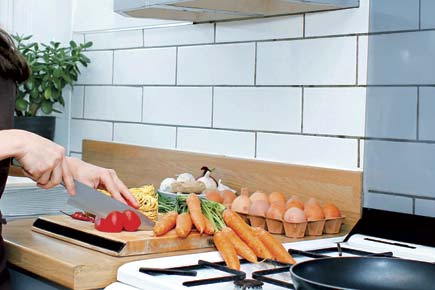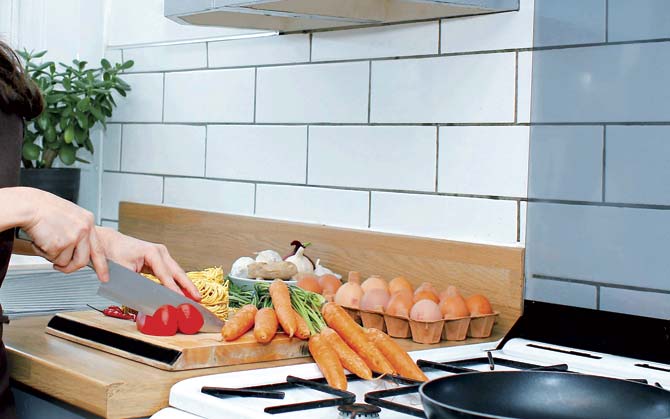Why is it such a challenge to get a food show that showcases healthy food? Or a column on food that goes beyond the googled-facts-on-green-food

 Why is it such a challenge to get a food show that showcases healthy food? Or a column on food that goes beyond the googled-facts-on-green-food. It stands to reason that in a country with myriad illnesses, many being traced to our food habits, this would be the biggest gap in the market. What about a Nigella Lawson kind of host who tells you how to make steamed chicken meatballs and spaghetti, with very little oil? And burgers with yogurt instead of mayonnaise or a cold chicken salad with fat-free mayonnaise - all of which I make at home by the way?
Why is it such a challenge to get a food show that showcases healthy food? Or a column on food that goes beyond the googled-facts-on-green-food. It stands to reason that in a country with myriad illnesses, many being traced to our food habits, this would be the biggest gap in the market. What about a Nigella Lawson kind of host who tells you how to make steamed chicken meatballs and spaghetti, with very little oil? And burgers with yogurt instead of mayonnaise or a cold chicken salad with fat-free mayonnaise - all of which I make at home by the way?
ADVERTISEMENT
Why, oh why is media so banal when it comes to sexing up good, healthy food!!

In a country where heart disease and pulmonary ones are the biggest killers why is all the writing and other media around healthy food so banal? pic for Representation/ Thinkstock
Disclosure - like most Indians I love my food and, more importantly, love cooking. So when broadcasters started showing food shows, I happily dumped my recipes, cut from magazines and microwave manuals, and started watching. Nigella is nice, but everything she makes is out of a can. Most of the Indian and foreign cookery shows use oodles of oil. Jamie Oliver, The Good Cook and maybe a couple of others were the only ones which showed food that could be cooked at home and not cause a heart attack if you ate it regularly.
Man versus Food, where Adam Richman takes on challenges such as eating the spiciest food or a massive five pound sandwich stuffed with all kinds of things seemed interesting to start with. The sight of patrons in some local restaurant in the US egging him on added to the tension. But within a few episodes, the sight of so much food being wasted in forcible eating seemed sickening. The morality apart, most of the stuff that Adam has eaten over four seasons from 2008 to 2012 is terrifically unhealthy food processed, deep fried and loaded with pork, beef or red meats. It is food you treat yourself to once in a while, but to eat that for a living must spell quick death or, at least ill-health.
That is when I went and bought some fat cookery books. And use them in conjunction with the iPad to look for substitutes and figure out low fat recipes of things we like to eat. The need gap is apparent. Indians are prone to high cholesterol and therefore heart disease is the primary cause of death going by WHO numbers. Also we must have among the worst eating habits in the world. Typically we eat dinner long past our bodies can digest it and then sleep almost immediately thereafter. Some of the healthiest societies in the world eat dinner between 6:30 and 8 pm - the Dutch for instance, or the Koreans. They usually party after that. And for the before-bedtime-hunger-pangs there is always a light snack or milk.
In my family alone, there are three adults with different health issues that require different dietary restrictions. For instance, my husband has high cholesterol (a genetic curse). It has taken years of experimenting to find low-fat substitutes for butter (hung curd), mayonnaise or how to make lighter parathas. We even make peanut butter at home (it is very easy). But I am yet to watch a channel do a series on cooking for a household with cholesterol issues. The few times that Indian food shows tackle low fat or ‘healthy’ cooking throws up hilarious moments. So this lady is teaching you to make spinach cutlets - which have more potato and flour than spinach and are then deep fried. How on earth can they be healthy?
What about food shows that tackle lifestyle diseases - blood pressure, diabetes or arthritis. Many of these require special diets. For instance, I have rheumatoid arthritis and therefore follow the Ayurvedic principles on diet which are based on body type. Hypothyroidism is very common in women in India. But did you know that soya milk is not good for people with hypothyroidism?
Getting a dietician, a professional chef and an Ayurvedic doctor together to think of tasty but healthy foods for people with lifestyle diseases should be a hit - at least in theory. Because food, oil and consumer healthcare firms would happily sponsor this one. Till then I will stick to my cookbooks, iPad, Google and food bloggers.
The writer is a media specialist and author. Follow her on twitter at https://twitter.com/vanitakohlik
 Subscribe today by clicking the link and stay updated with the latest news!" Click here!
Subscribe today by clicking the link and stay updated with the latest news!" Click here!







